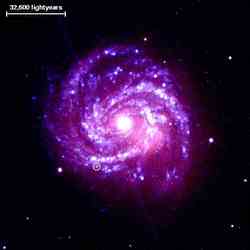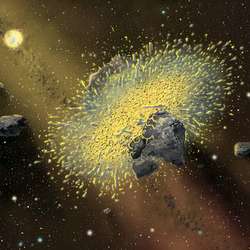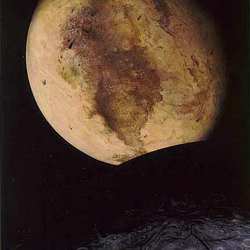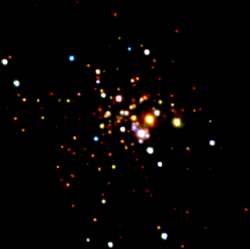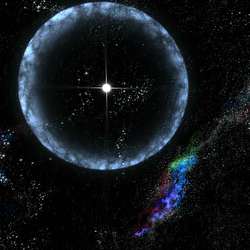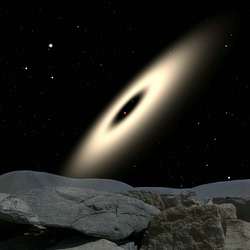
The impact crater, known as “Endurance”. Image credit: NASA/JPL/Cornell. Click to enlarge
Mars is the planet that refuses to say “die.” In 1996, after centuries of speculation about canals, icecaps and vegetation, NASA’s David McKay reported seeing traces of ancient bacteria in a meteorite from Mars. Scientists have debated this finding ever since, and many now believe that the intriguing traces are probably not of biological origin.
Within the last few years, however, two simple chemicals intimately associated with life on Earth have been discovered on Mars. Large amounts of frozen water were discovered at the surface, and traces of methane appeared in the atmosphere.
Water is necessary for life as we know it, and most of the methane on Earth is made by microbes. Although the twin discoveries redoubled interest in the possibility of life on Mars, nobody is suggesting that anything is living on the planet’s surface, where temperatures average minus 63 degrees Celsius and harmful ultraviolet radiation pierces the thin atmosphere.
On Mars, as on Earth, temperatures rise as you go deeper down into the planet. Somewhere between a dozen and a thousand meters below the surface, conditions may be warm enough for liquid water, which is necessary for even non-biological methane production on Earth. But could a living ecosystem be hidden deep under the martian surface? On Earth, subterranean microbes survive without sunlight, free oxygen, or contact with the surface.
The question becomes more intriguing when you consider that most deep-Earth microbes are primitive, single-celled organisms that power their metabolism with chemical energy from their environment. These microbes are called “methanogens” because they make methane as a waste product.
Three NASA missions have discovered signs of water on Mars. In 2000, Mars Global Surveyor images of gullies suggested to many that water recently flowed on the martian surface. In May 2002, the gamma ray spectrometer on Mars Odyssey found a huge deposit of hydrogen in shallow polar soil — a sure sign of water ice. Then, in December 2004, researchers using the Mars Exploration Rover Opportunity announced that they had discovered rocks that had been formed by the periodic flooding of water on the surface. Such findings support the idea that Mars was warm and wet billions of years ago.
While water is a necessary condition for life, methane may be actual evidence of life. In the past two years, three separate research groups have seen spectral signs of methane on Mars:
* In 2003, Michael Mumma of Goddard Space Flight Center (GSFC) detected methane using spectrometers at two large earthbound telescopes. He has since told several scientific meetings that large variations exist in methane concentration on Mars. In a presentation at a NASA Astrobiology Institute meeting in April 2005, Mumma said the detection of martian methane varied with geography: there was an average of 200 parts per billion (ppb) detected at the equator, and 20 to 60 ppb near the poles.
* Vladimir Krasnopolsky, a research professor at Catholic University of America in Washington D.C., also detected methane on Mars. Like Mumma, Krasnopolsky used spectrometers on Earth-based telescopes. He calculated a global average of 11 ppb, with a range of 7 to 15 ppb. The data, as Krasnopolsky reported to a European Geosciences Union meeting in April 2004, came from 1999 observations of the whole planet’s disk.
“We didn’t try to make localized measurements because we did not expect any variation from place to place,” Krasnopolsky told Astrobiology Magazine.
* In December 2004, the European Space Agency’s Mars Express delivered the first methane data from a Mars orbiter. In the journal Science, Vittorio Formisano of the Institute of the Physics of Interplanetary Space in Rome and colleagues reported measurements made with the satellite’s Planetary Fourier Spectrometer. Their measurements were similar to Krasnopolsky’s numbers: A concentration of 10 ppb, plus or minus 5 ppb.
Although the Krasnopolsky and Formisano studies independently pointed to similar concentrations of methane, some planetary scientists express skepticism because the amount detected is very faint.
“The detections have been right at the detection limit of the instruments,” says William Boynton of the University of Arizona, principal investigator on the gamma ray spectrometer on Mars Odyssey. “I’m not completely convinced it’s a solid detection yet. It’s likely, but I wouldn’t put it in the bank.”
The matter of methane
The methane on Mars was detected with spectrometry — the analysis of light waves. Because each atom and molecule emits and absorbs characteristic wavelengths of light, spectrometers can determine the composition of distant objects by measuring these wavelengths. To study gases in the atmosphere of Mars, spectroscopists use instruments that can analyze the infrared light that is emitted when solar radiation warms the planet’s surface. As that infrared radiation speeds toward Earth, gases in the martian atmosphere can block, or absorb, certain frequencies. When the infrared light is concentrated in a telescope and separated by a spectroscope’s diffraction grating, the missing wavelengths show which particular atoms or molecules have absorbed light en route to Earth. Thus, a methane “line” on a spectroscope curve is a reflection of the light that methane has blocked.
There are complications, however. When faint light from a planet is collected in a terrestrial telescope, atoms and molecules in space or in Earth’s atmosphere will block some wavelengths. Spectroscopists must compensate for these non-martian signals. And because Mars is moving relative to Earth, the absorption lines appear in the “wrong” places until additional compensations are made.
Any methane on Mars today is not a legacy of ancient conditions, because solar radiation would destroy the molecules in the atmosphere within 600 years. Instead, the methane either was brought to Mars on comets or meteorites, or it was made on Mars. If we have glimpsed some made-on-Mars methane, was it made by geological or chemical processes — or by biology?
Original Source: NASA Astrobiology


